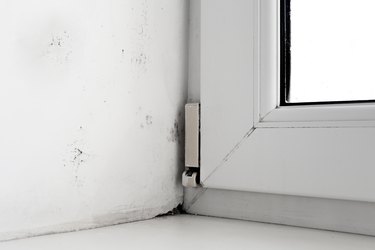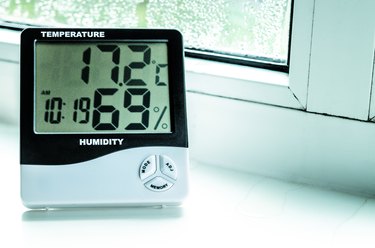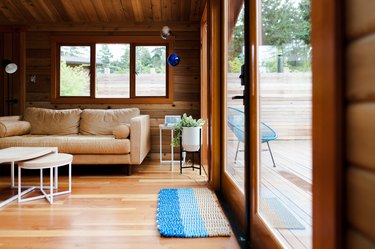The basement humidity level in any home depends on where the home is located, site conditions, and moisture levels in the basement. You can't do much about the local climate, but you can take steps to regulate basement humidity levels to make the space comfortable and to protect anything in the basement from possible damage.
The ideal basement humidity levels is between 30 and 50 percent. Higher levels can make the space uncomfortable and help promote mildew and mold growth, while low humidity levels can cause dry skin, irritated nasal passages, respiratory problems, and other health issues.
Video of the Day
Video of the Day
Many people believe controlling basement humidity is confined to finished basements that are used as living spaces. But humidity levels are important in any type of basement. The items placed in unfinished basements that are used for storage can also suffer from high humidity levels. Clothing stored in a basement can develop unpleasant odors because of mildew. Parts of wood furniture can swell and/or crack, and photos and documents can become damaged.
Signs of High Humidity in Your Basement

The first sign is the way you feel when you walk into your basement. If it feels humid, it probably is. Similarly, if you notice a musty smell, excess moisture is the likely culprit.
Standing water can raise the humidity level. Basements that flood after a rainstorm can have high humidity levels. Basement walls that feel damp mean that moisture contained in the soil is working its way into the basement, raising the humidity level. Look for efflorescence — white salt deposits left behind as water vapor migrates through the concrete basement floor or walls.
You might find condensation on metal surfaces when warm, humid air from outside comes in contact with cooler temperatures in the basement. Look for condensation on metal window frames as well as rust on metal appliances and heating and cooling equipment.
The items stored in the basement can also show signs of high humidity levels. Clothes and fabrics on furniture may smell musty. You may also find signs of mold on drywall, furniture, or other items stored in the basement.
7 Signs You have High Humidity in Your Basement
- Humid air
- Musty smell
- Standing water
- Damp walls
- Efflorescence on basement floor or walls
- Condensation on metal surfaces
- Mold or mildew
Causes of High Humidity
When people talk about high humidity, what they mean is high relative humidity. Relative humidity is the percentage of moisture vapor in the air compared to the total amount of vapor the air can hold at a specific temperature. In general, warm air can hold more moisture than cold air.
One of the reasons basement humidity levels can be high is because basements are built underground; they are surrounded by soil, and soil holds moisture. The moisture in the soil can push against basement walls and floors — an effect called hydrostatic pressure — and moisture can be pushed through porous concrete foundation walls and floors. Cracks in the walls, even tiny ones, can let in moisture.
The way we live in basements can also produce humidity. Basement bathrooms can add to the area's humidity levels if they are used for showering and bathing. Using clothes washers and dryers (if not properly ventilated) can introduce moisture into the air.
Air leaks can also increase basement humidity. Drafty doors, windows, and structural joints can let warm, humid air into the basement, raising the relative humidity and potentially leading to condensation on cold surfaces.
How to Measure Basement Humidity

If your basement feels humid, you should start monitoring the moisture level. You can get precise measurements by using an instrument called a hygrometer. Hygrometers are relatively inexpensive devices that usually measure relative humidity, and most also report the air temperature. You can find both digital and analog hygrometers as well as hygrometer apps for smartphones. With some setups, remote sensors are connected by Bluetooth to send humidity levels to the phone.
Standalone hygrometers are usually battery-powered. Look for ones that refresh frequently to provide the latest reading. Some models record the high and low humidity levels during a given period so that you can compare levels at different times.
To use a hygrometer, follow the manufacturer's directions. In general, take measurements in a few areas around the basement. Don't place a hygrometer near anything that produces moisture, such as a bathroom or unvented clothes dryer. Position the instrument about 5 feet off the floor.
How to Lower Basement Humidity
If there is excess humidity in your basement, there are steps you can take to lower it. Here's a list of possible strategies. You may need a combination of approaches to lower the humidity level.
- Check the gutters and downspouts. Make sure the gutter system directs water away from the foundation of the house because poorly designed and installed gutters and downspouts can lead to basement flooding. A more drastic option is to install a drain tile system, which consists of a buried drainage pipe installed around the foundation walls to direct water to a sump pump that discharges the water away from the house.
- Add a dehumidifier. You can incorporate a whole-house dehumidifier into your home's forced-air heating and cooling system. An HVAC contractor will install the unit at a cost of up to $3,500. For most homes with seasonally damp basements, a better option is a portable dehumidifier. A good-quality portable unittypically costs between $150 and $300.
- Ventilate the basement. Moving air can remove moisture-laden air. Sometimes, simply opening windows is enough, although you may want to use ventilating fans as well. However, this method does not work if the outside air is humid since you will just be introducing more humid air into the space.
- Use spot ventilation. If there is a bathroom in the basement, be sure to have a exhaust fan that is ducted to the outdoors, and always run the fan during and after showers or baths. Clothes dryers also must be ducted outdoors — never into the room.
- Seal and insulate the basement. There are a variety of ways to airseal and insulate a basement to prevent outside air from entering the space. Windows and doors are especially vulnerable to air leaks. Consult an insulation contractor for the best method for your home.
- Plug the leaks. Concrete basement walls can develop cracks over time, and there may be gaps around windows and window wells. You can fill small cracks with hydraulic cement and caulk, and then apply a waterproof sealer over the entire area. For big jobs, consult a masonry contractor.
